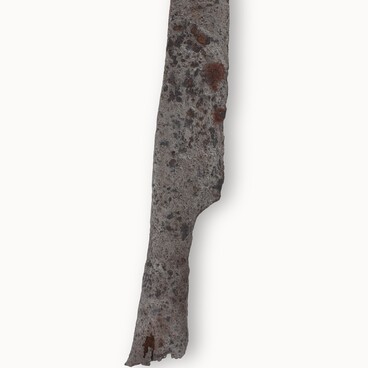The Kursk Regional Museum of Archaeology displays a bronze openwork pin headpiece with the remainder of an iron needle. It was found in 1962 during the excavations of the Alexandrovskoye ancient settlement, located on the right bank of the Seim River in the Kurchatov district of the Kursk region. The archaeologist Anna Yepifanovna Alikhova led the excavations.
The archaeologist and expert on the Palaeolithic art Artur Chubur describes the piece as an ornament with an inscribed second outline, in which triple nervures (five pairs) form a “herringbone” pattern with an upward slope from the corrugated axis. The outer edge has triple radial nervures (12 pairs). This jewelry piece is 88mm long and 52mm wide. The outer rim has four rows: two outer falsely twisted ones and two inner smooth ones. The inner outline has three rows: two outer falsely twisted ones and the inner smooth one. There is a double smooth loop on the front side at the bottom. Symmetrically underneath, two S-shaped volutes can be seen on the reverse side.
Anna Alikhova attributed this openwork pin to the 4th–3rd centuries BC. The Alexandrovskoe settlement was inhabited for a very short time, which provided reliable material, for instance, Scythian arrowheads to determine the timeline. Most of the openwork pin headpieces were made and cast using a wax model. A craftsman would make a model of the item and then pour liquid clay into all the depressions of the mold. The mold was dried, the wax was melted and the threads were churned out during firing. The mold was then washed and the metal was poured into it. When it cooled down, the mold was broken. As a result, each piece of jewelry was made unique.
It is quite common that jewelry in the form of large pins with an iron or bronze needle riveted to it is found on the territory of Early Iron Age settlements in the forest and forest-steppe zones of central Eastern Europe. In some cases, the pins were not bimetallic (made of two metals), but were full metal ones, for instance cast of bronze. There are also examples that were entirely carved out of bone. The corpus of such items has a broad dating of the 4th or 2nd century BC. It is likely that this type of jewelry fell out of use in the area by the beginning of the Common Era.
The archaeologist and expert on the Palaeolithic art Artur Chubur describes the piece as an ornament with an inscribed second outline, in which triple nervures (five pairs) form a “herringbone” pattern with an upward slope from the corrugated axis. The outer edge has triple radial nervures (12 pairs). This jewelry piece is 88mm long and 52mm wide. The outer rim has four rows: two outer falsely twisted ones and two inner smooth ones. The inner outline has three rows: two outer falsely twisted ones and the inner smooth one. There is a double smooth loop on the front side at the bottom. Symmetrically underneath, two S-shaped volutes can be seen on the reverse side.
Anna Alikhova attributed this openwork pin to the 4th–3rd centuries BC. The Alexandrovskoe settlement was inhabited for a very short time, which provided reliable material, for instance, Scythian arrowheads to determine the timeline. Most of the openwork pin headpieces were made and cast using a wax model. A craftsman would make a model of the item and then pour liquid clay into all the depressions of the mold. The mold was dried, the wax was melted and the threads were churned out during firing. The mold was then washed and the metal was poured into it. When it cooled down, the mold was broken. As a result, each piece of jewelry was made unique.
It is quite common that jewelry in the form of large pins with an iron or bronze needle riveted to it is found on the territory of Early Iron Age settlements in the forest and forest-steppe zones of central Eastern Europe. In some cases, the pins were not bimetallic (made of two metals), but were full metal ones, for instance cast of bronze. There are also examples that were entirely carved out of bone. The corpus of such items has a broad dating of the 4th or 2nd century BC. It is likely that this type of jewelry fell out of use in the area by the beginning of the Common Era.




